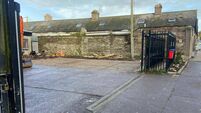Protecting our heritage is important
Walking is by far the most popular, outdoor recreational past-time in Ireland today and, given reasonable weather, there’s no better way to see the countryside and experience at close quarters aspects of our natural and man-made heritage.
And though much of that heritage has been destroyed in the last 30 to 40 years, there is much that is worth cherishing that still remains.
A new study on the value people in Ireland place on heritage also gives hope as it shows that we are becoming increasingly concerned about the need to safeguard our heritage.
We’re not just talking about listed national monuments, but also about simple things like fields, trees, stone walls, ditches and hedgerows — some hundreds of years old, providing habitat for a large amount of plants and wildlife.
The vast majority of those surveyed agree that new measures and extra funding should be put in place as people are becoming increasingly concerned about the effect of development on national heritage.
Heritage Council chief executive Michael Starrett, commenting on the latest study, said: “This research shows a huge growth in public support for safeguarding our heritage. It also shows that people are willing to pay to safeguard heritage and that protecting heritage ranked fifth in line for public spending after health and ahead of roads or the arts.”
In an era when people’s health has become almost an obsession, the main finding of the study should not come as a surprise — almost 70% believe that walks and access to the countryside should be protected for the sake of health.
Health is certainly a very worthy reason for taking to the great outdoors but walks can also be enjoyed for their own sake and for the way they help us appreciate nature and the beauty of the countryside.
On Thursday and Friday of last week, the Irish Examiner, in association with the Irish Sports Council, issued two pocket guides, titled Great Irish Walks.
Included are some of the great walks such as the Sheep’s Head Loops, the Munster Way, the Dingle Way, the Bluestack Way, the Western Way and several others.
You don’t have to be a mountaineer to enjoy the walks: many are suitable for recreational walkers. Some of the walks can be completed in a couple of hours while others, such as the 153km Dingle Way, are divided into sections, each representing a half day’s walking.
But back to the aforementioned study, carried out for the Heritage Council on previous Heritage Council surveys from 1999 to 2004.
More than 92% of those surveyed agree it is important to protect our heritage, while 92% think that people should be penalised for damaging heritage (up from 51% in 1999). Ninety percent are proud of our heritage (up from 83%).
Personal health is a key motivation for people’s desire to enhance the protection of heritage and the environment. However, this motivation is combined with a social awareness of significant threats to the environment and a concern for future generations.
People’s main reasons for protecting heritage include:
Personal health — 68% of people agree that protecting our natural heritage for walks, enjoyment and recreation is vital for health protection.
Threats to the environment — 65% agree that safeguarding water quality and biodiversity is vital for our environment.
Concern for future generations — 52%.
General interest in Ireland’s history and culture — 47%.
General interest in Ireland’s wildlife — 40%.
A key point to emerge from the study is that 68% of interviewees believe there should be more public spending on heritage protection.
People’s willingness to pay for this additional protection averages an extra 47 per taxpayer per annum, a figure that amounts to a total of €90 million in additional funding.
Almost 30% feel money should be spent on inland waterways — restoration of rivers, canals, lakes and associated facilities for amenity _ while 22% say coastal landscapes should be improved, with 12 wildlife habitats as a priority.














